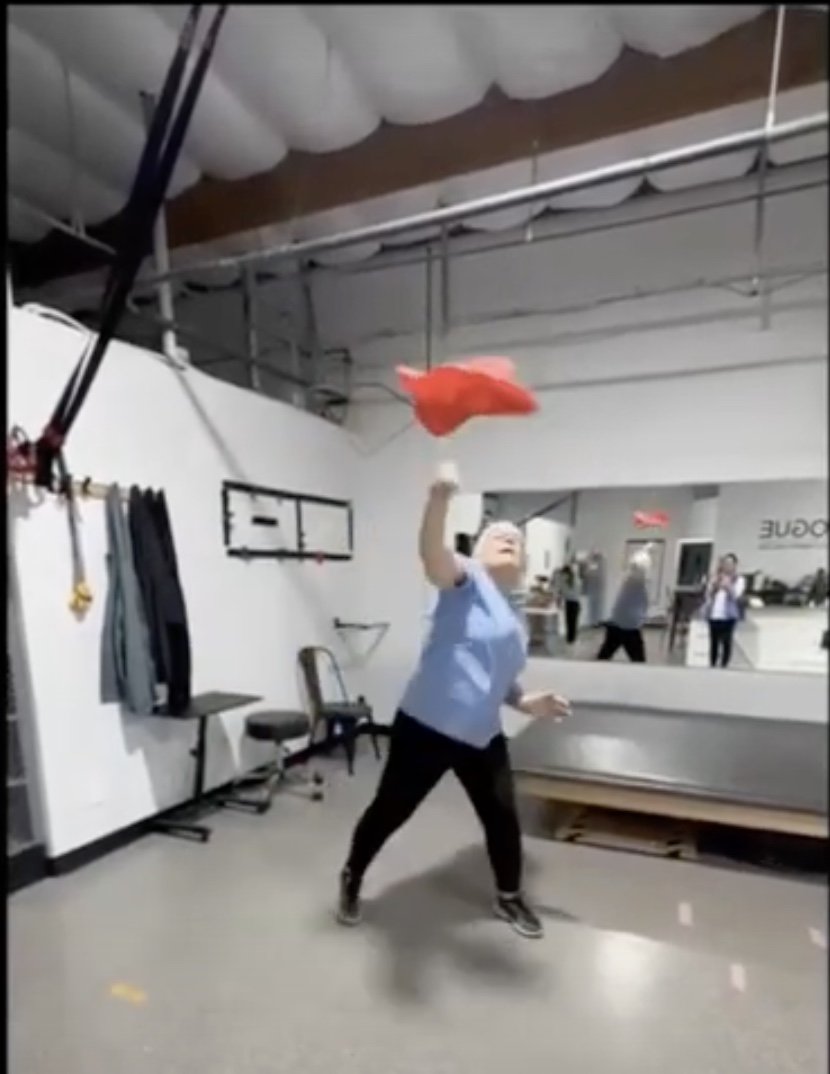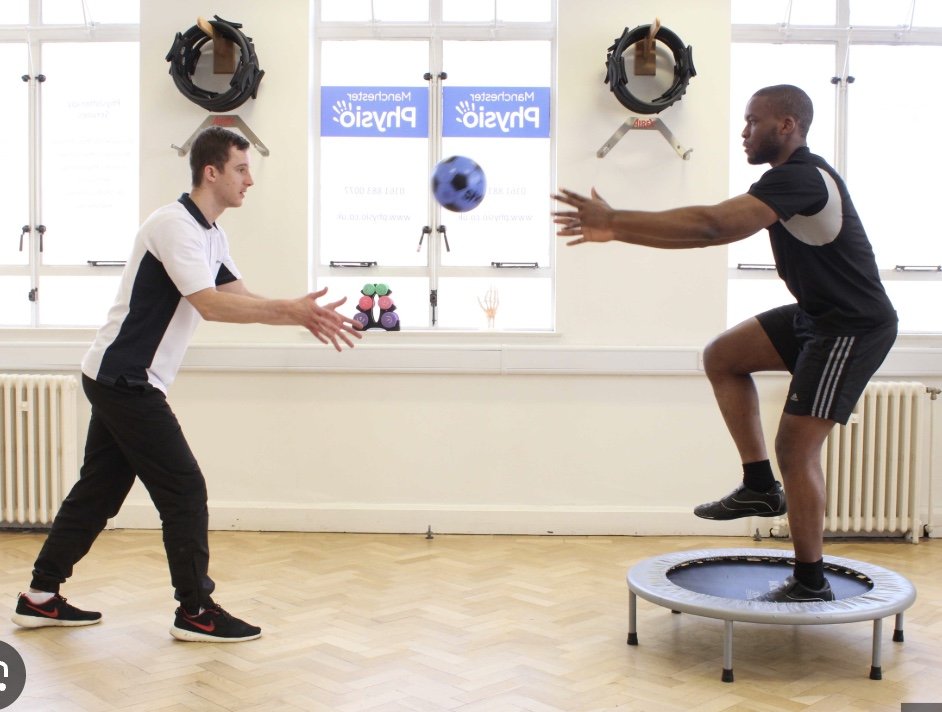From Falls to Stability: The Power of Reactive Balance Training
Falls are one of the biggest challenges for individuals with Parkinson’s, often leading to injuries, loss of confidence, and reduced independence. That’s why understanding balance, postural control and different types of balance is crucial in preventing falls and maintaining mobility.
In this blog, we’ll break down what balance is, how our bodies control it, and why improving these skills can make a life-changing difference.
One of the most effective ways to improve stability and prevent falls is through Reactive Balance Training (RBT), a specialized approach that challenges the body to respond quickly and effectively to unexpected balance disruptions. We’ll explore key aspects of RBT, the types of exercises that fall under this category, and why incorporating them into a routine can build resilience against falls. By the end of this blog, you’ll have a deeper understanding of how to enhance balance control and take proactive steps toward greater stability and confidence in daily life.
Finding Your Center: Understanding Balance
Balance is the ability to stay upright and steady by evenly distributing weight and keeping the body’s center of gravity (COG) within its base of support (BOS). When these factors are properly aligned, a person can maintain stability while standing, walking, or moving in different directions. Any disruption in weight distribution or COG control can lead to unsteadiness and an increased risk of falls.
The body relies on three key systems to maintain balance:
The Visual System - helps interpret the surroundings
The Vestibular System - detects head movements and spatial orientation
The Proprioceptive System - provides feedback about body position
These systems work together to create a sense of stability, allowing for smooth and controlled movement.
Mastering Balance: How Postural Control Keeps You Steady in Any Situation
Postural Control is the body’s ability to maintain equilibrium in any situation, ensuring stability during movement and rest. This process relies on a flexible, automatic system that can respond to both expected and unexpected challenges. To achieve this, the body uses a combination of feedforward mechanisms, which prepare for movement in advance, and reactive strategies, which adjust to sudden changes.
Effective postural control depends on multiple systems working together which includes the following:
Somatosensory System - provides feedback on body position
Vestibular System - detects head movement and spatial orientation
Neuromuscular System - coordinated muscle responses
When these systems function properly, they help maintain balance and prevent falls.
The Science of Stability: How Your Body Maintains Balance and Control
Balance Control is simply the body’s ability to keep the center of mass within its base of support, ensuring stability during movement and standing. A fall happens when the center of mass moves beyond this base, and the body lacks a reactive strategy to regain control. In biomechanical terms, this loss of stability is referred to as the center of mass being perturbed, meaning it has shifted out of alignment with the base of support.
When the center of mass is no longer stable relative to the base of support, the body must rely on quick adjustments to prevent a fall. These adjustments may include stepping, shifting weight, or using the arms for balance. If the body fails to react in time, the loss of stability can lead to a fall, increasing the risk of injury.
Why Postural Control Matters: Preventing Falls and Staying Strong
Falls can happen to anyone, regardless of age or physical ability, and often result from slips, trips, or loss of balance. These incidents can lead to injuries ranging from minor bruises to more severe consequences like fractures or head trauma. Such injuries may impact mobility, independence, and overall quality of life, making fall prevention essential.
One of the most effective ways to reduce the risk of falls is through balance training, which strengthens the body’s ability to react and recover from sudden shifts in stability. Improving balance enhances coordination, posture, and muscle strength, helping to prevent slips and trips before they happen. By incorporating targeted exercises, individuals can build confidence in movement and maintain greater control over their stability.
Why Preventing Falls Matters
According to the CDC, nearly one in four American community-living older adults experience at least one fall each year, making falls a significant public health concern. Among individuals over the age of 65, falls are the leading cause of injury-related deaths, highlighting the serious consequences they can have on an older adult’s health and well-being. In addition to fatal outcomes, falls are also the primary cause of nonfatal injuries and trauma-related hospitalizations, often resulting in long recovery periods and reduced independence.
Given these risks, fall prevention is crucial for maintaining mobility and quality of life in older adults. Regular balance training, strength exercises, and environmental modifications can significantly reduce the likelihood of falls. By prioritizing fall prevention strategies, individuals can enhance their stability, remain active, and lower the chances of hospitalization due to fall-related injuries.
Exploring the Different Types of Balance
Balance control can be categorized into static and dynamic balance, as well as anticipatory and reactive responses.
Static Balance - maintaining stability while stationary
Dynamic Balance - controlling stability during movement
Both types rely on the body’s ability to anticipate or react to changes in position and external forces.
Anticipatory Postural adjustments - occur before a voluntary movement begins, activating postural muscles in a feedforward manner to prepare for potential destabilization.
Reactive balance - involves responding to unexpected disturbances, where the individual does not initiate movement but instead reacts to maintain stability.
Both anticipatory and reactive mechanisms are essential for preventing falls and ensuring smooth, controlled motion.
Key Aspects of Reactive Balance Training (RBT)
Reactive Balance Training involves introducing perturbations to challenge the body’s ability to recover from unexpected disturbances. A perturbation is any disruption to motion, positioning, or equilibrium that forces the body to respond and regain stability. This type of training enhances an individual’s ability to react quickly and effectively to balance challenges, reducing the risk of falls.
Perturbations can be classified as internal or external based on their cause.
Internal Perturbations - occur when an individual is engaged in a voluntary activity but fails to control their center of mass effectively.
External Perturbations - come from environmental factors, such as an unexpected push or an uneven surface, which shift the center of mass beyond the limits of stability.
Training both types of responses helps improve overall balance control in daily life.
Exercise Types for Reactive Balance Training (RBT)
Reactive Balance Training
Pickleball - Fast-paced play with unpredictable ball movement requires quick adjustments, lateral movement, and dynamic balance control
Perturbation Balance Training - using external forces (nudges, pushes, or sudden movements) to challenge stability and train automatic reactions
Slip and Trip Recovery Drills - simulating real-life scenarios like slipping on a slick surface or catching a toe to improve stepping responses
Boxing / Sparring with a Partner - reacting to an opponent’s movements and strikes challenges coordination, stability, and rapid weight shifts
These activities challenge the body’s reactive response by introducing unpredictable forces or movements.
Not Reactive Balance Training
PWR! Moves - Although designed for Parkinson’s-specific movement, the focus is on intentional, large-amplitude movements rather than quick reactive responses.
Tai Chi - While great for balance and control, these emphasize deliberate, slow movements rather than quick reactive responses.
HIIT / Shadow Boxing - While high-intensity and engaging, the movements are pre-planned, lacking the unpredictable balance demands of sparring or reactive drills.
Aerobic Exercise - Activities like jogging, cycling, or step aerobics focus on endurance rather than sudden balance reactions.
Good News & Bad News About Reactive Balance Training
Good News
Many types of exercise can help improve reactive balance, making it easier to recover from unexpected stumbles or shifts in stability.
Balance Training
Gait / Agility Training
Strength Training
Power Training
Incorporating these exercises into a routine can enhance coordination, muscle activation, and overall responsiveness to balance challenges.
Bad News
While these exercises help, they can be challenging to do on your own. Since this type of training requires unpredictable disturbances, such as external forces or sudden shifts in movement, having a partner, trainer, or structured program is often necessary.
With proper setup and guidance, it’s difficult to simulate real-life balance challenges that truly test and improve reactive responses.
Gold Standard for Training Reactive Balance
Slip/Trip Training
directly targets the body’s ability to recover from sudden balance disturbances. By practicing controlled slips and trips in a safe environment, individuals learn to react more effectively, improving their ability to regain stability and prevent falls. This type of training mimics real-world situations where unexpected balance loss occurs, making it one of the most effective methods for fall prevention.
One session of slip/trip training can reduce the risk of falls by 50% for an entire year
This impressive statistic highlights the lasting benefits of training the body’s reactive responses. Unlike traditional balance exercises, which focus on controlled movements, slip/trip training forces the body to adapt instantly - building reflexes and muscle memory that can make a life-changing difference in fall prevention.
How to Find a Physical Therapist Specializing in Parkinson’s & Reactive Balance Training
Finding a physical therapist who specializes in Parkinson’s and incorporates Reactive Balance Training can make a significant difference in fall prevention and overall mobility. A great place to start is by looking into organizations such as:
Parkinson’s Wellness Recovery
LSVT Global
American Physical Therapy Association
Ask if they offer slip/trip training or have access to a moving platform for reactive balance exercises.
At Rogue in Motion, we take fall prevention seriously. Our Slip Trip Training Program is designed specifically for people with Parkinson’s to improve reactive balance and reduce the risk of falls. Using controlled, real-world challenges, we help retrain the body’s ability to recover from slips and trips - before they happen in daily life.
Finding a therapist with expertise in these techniques ensures a more effective and personalized approach to reducing fall risk and improving movement confidence.
Other Ways to Train Reactive Balance with a Physical Therapist
Overhead Harness System - allows for intense balance challenges without the risk of falling. This setup helps you practice quick recovery movements in a controlled, safe environment.
Unpredictable Foot Disruptions - a slider, towel, or foam pad can be pulled out from under your foot, forcing you to react and regain balance.
Ways to Train Reactive Balance on Your Own (or with a Partner)
Ball Drills - tossing and catching a ball in unpredictable ways helps train reaction time and stability.
Against a wall - throw at different angles to challenge foot positioning
In the air - vary heights and directions
On the floor - bounce passes force quick adjustments
With a partner - have them mix up throws to keep you on your toes
Scarf Tossing - lightweight scarves move unexpectedly, making you react faster.
Outside on a windy day - add extra unpredictability
With a fan indoors - creates constant movement challenges
Bungee Training - resistance bands or bungees force reactive steps when tension suddenly changes.
At the hips - attached to a wall or held by a partner, forcing quick recoveries
In the hands - sudden pulls make you adjust your balance fast
The goal is to create situations where you have to take a step without planning it - just like real-life balance challenges.
Final Thoughts
Falls are not an inevitable part of Parkinson’s - by training the body’s ability to react quickly and efficiently, we can build greater stability and confidence in movement. Reactive Balance Training challenges the nervous system, strengthens postural control, and reinforces the quick adjustments needed to stay upright in real-world situations. With the right exercises, tools, and guidance, fall prevention becomes an active, achievable goal rather than a passive concern.
If you’re in the Orange County, California area, you can check out our in-person classes at Rogue Physical Therapy and Wellness. Join us in person here.
But if there aren’t any gyms near you, you can still get expert-led Parkinson’s-specific workouts with our online classes like this one.
By incorporating balance-focused activities and seeking expert support when needed, individuals can take control of their mobility and reduce the risk of injuries. Whether through structured training with a physical therapist or simple at-home exercises, every step toward better balance is a step toward greater independence.
With dedication and the right strategies, staying steady on your feet isn’t just possible - it’s empowering.








